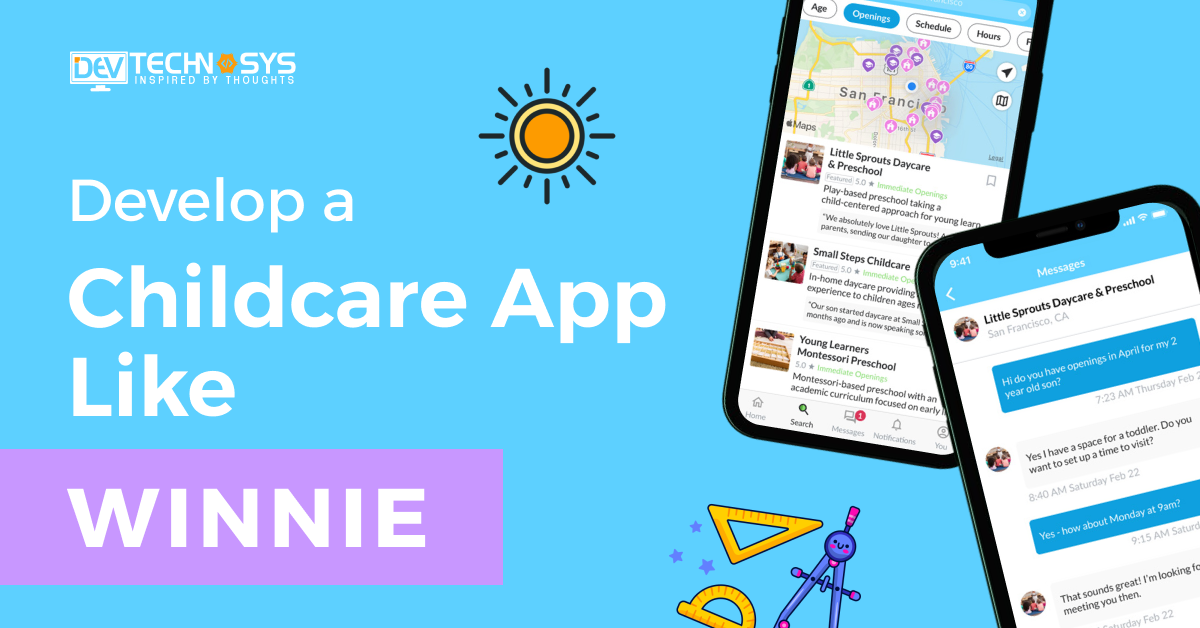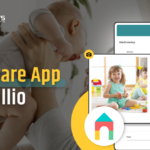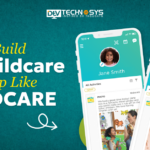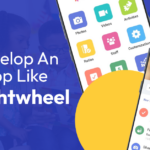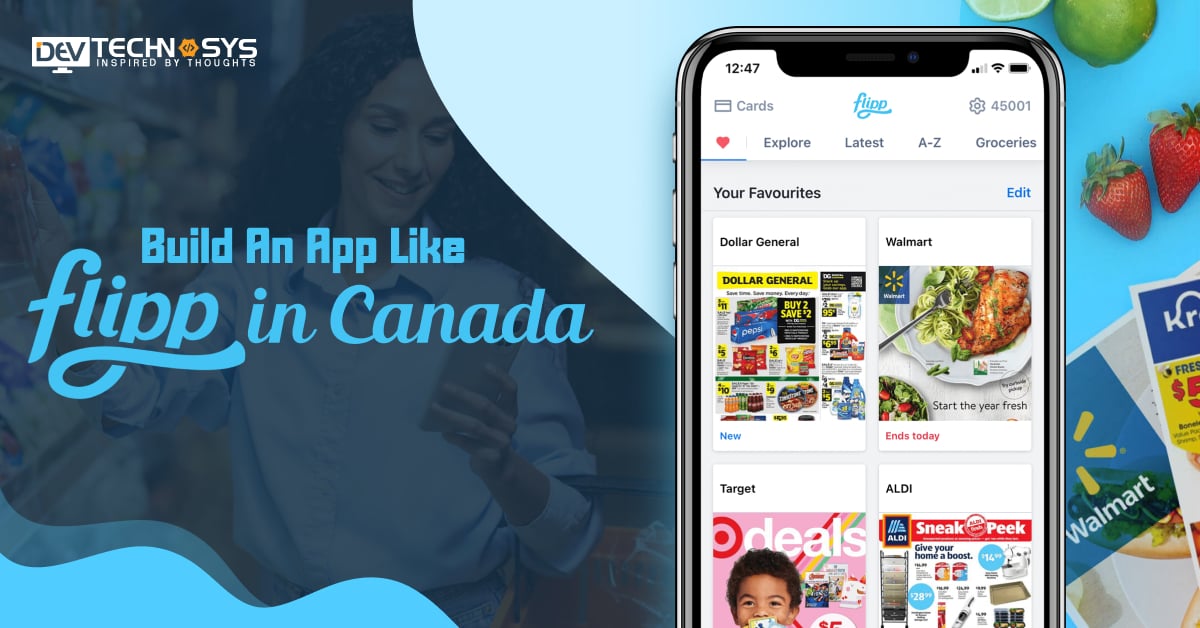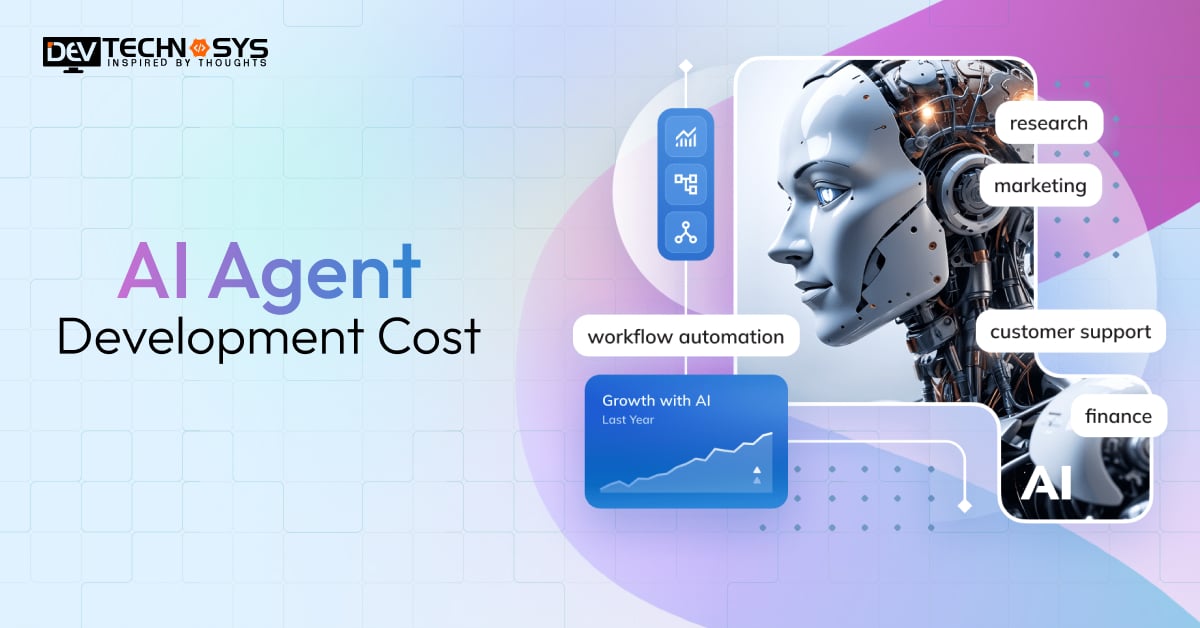In today’s fast-paced world, finding reliable child care can be challenging for many parents. That’s why apps like Winnie are becoming so popular; they help families easily discover trusted babysitters, daycares, and parenting tips all in one place.
But have you ever wondered how such a helpful app is made?
In this guide, we’ll explore how to develop a childcare app like Winnie.
Key takeaways:
-
- The worldwide child care services market was estimated at USD 295.6 billion in 2023 and is projected to expand at a CAGR of 33% from 2024 to 2030.
- Winnie’s success highlights the importance of community-driven content, easy navigation, and features that connect parents with local child care providers.
- Core features include child care provider listings, reviews, activity tracking, scheduling, and social networking for parents.
- Top apps like Winnie, Care.com, and Sittercity offer trusted platforms that combine comprehensive child care options with user-friendly interfaces and personalized recommendations.
I believe creating apps that solve real-life problems is both exciting and meaningful.
From planning the features to designing the user interface and coding the app, I’ll explain the steps involved in a simple yet professional way.
Whether you’re dreaming of becoming an entrepreneur or just curious about how apps work, this will give you a clear idea of what goes into building a successful and user-friendly child care app.
Let’s get started on this creative and rewarding journey!
Market Analysis of Global Child Care Applications
- According to GrandViewResearch, the size of the global market for child care services was projected to be USD 6 billion in 2023 and is projected to grow to USD 307.4 billion in 2025.
- The market for child care services is projected to reach USD 4 billion by 2030, growing at a compound annual growth rate of 4.33% between 2024 and 2030.
- Due to the growing number of child care facilities worldwide and the trend toward nuclear families, the center-based category led the child care services market in 2023 with a share of15%.
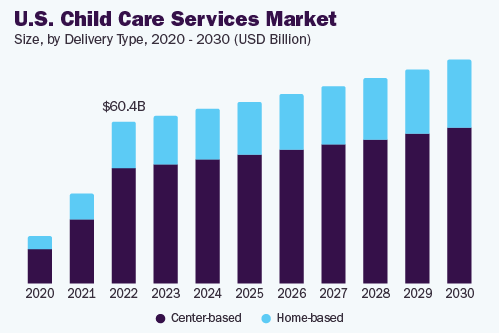
- With a market share of more than 70% in 2024, the Asia Pacific region led the pack.
- Prominent entities in the child care services sector include Bright Horizons Family Solutions Inc., KinderCare Learning Centers LLC, Learning Care Group, Inc., and Spring Education Group.
What is Winnie?
Winnie is a popular childcare app designed to help parents find trusted local daycare centers, preschools, and babysitters. The best babysitting applications, such as Winnie, offer comprehensive listings, detailed reviews, and real-time availability to simplify the search for quality childcare.
Winnie childcare app provides parenting resources, activity ideas, and community forums, creating a supportive platform where parents can connect, share advice, and make informed decisions about their child’s care and early education.
Analysis of a User Case: Winnie
- Winnie was launched in 2016 to simplify parents’ search for trusted local child care through comprehensive listings and real-time availability.
- Early success came from combining verified reviews, detailed provider profiles, and a community-driven approach, building strong user trust quickly.
- Achieved rapid growth with over 1 million parents using the app to find daycare, babysitters, and preschool programs nationwide.
- Partnerships with child care providers and local organizations helped expand Winnie’s database and improve service quality.
- User-friendly design and personalized recommendations contributed to high retention rates and positive word-of-mouth referrals.
- Funded by notable investors, Winnie raised over $10 million to scale its platform and improve app functionalities.
3 Different Types of Childcare Apps
Explore various apps for childcare categories, including provider directories, child development tools, and parent-teacher communication platforms, each designed to support parents and caregivers in managing child care effectively.
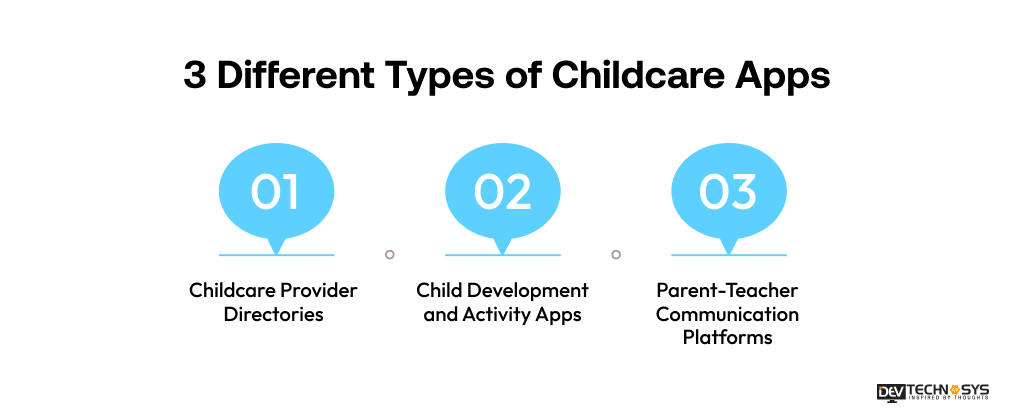
1. Childcare Provider Directories
Parents may use these applications to discover and compare nearby childcare facilities, preschools, and babysitters. They include verified listings, extensive evaluations, availability schedules, and occasionally booking possibilities. Winnie and Care.com are two examples of websites that help parents find reliable caregivers in their area.
2. Child Development and Activity Apps
The best kindergarten apps help youngsters grow by providing educational games, developmental milestone monitoring, and activity suggestions for parents and caregivers. They frequently contain tools for tracking learning development and materials geared to certain age groups to improve cognitive and motor abilities.
3. Parent-Teacher Communication Platforms
These childcare network apps, designed to enhance communication between parents and daycare providers or teachers, enable daily updates, photo sharing, and texting. They increase transparency and participation by keeping parents informed about their child’s activities, health, and growth throughout daycare or preschool hours.
Top 10 Childcare Apps Like Winnie
Discover the best preschool apps offering trusted daycare listings, babysitter connections, activity tracking, and parent communication tools to simplify finding and managing quality child care easily and securely.
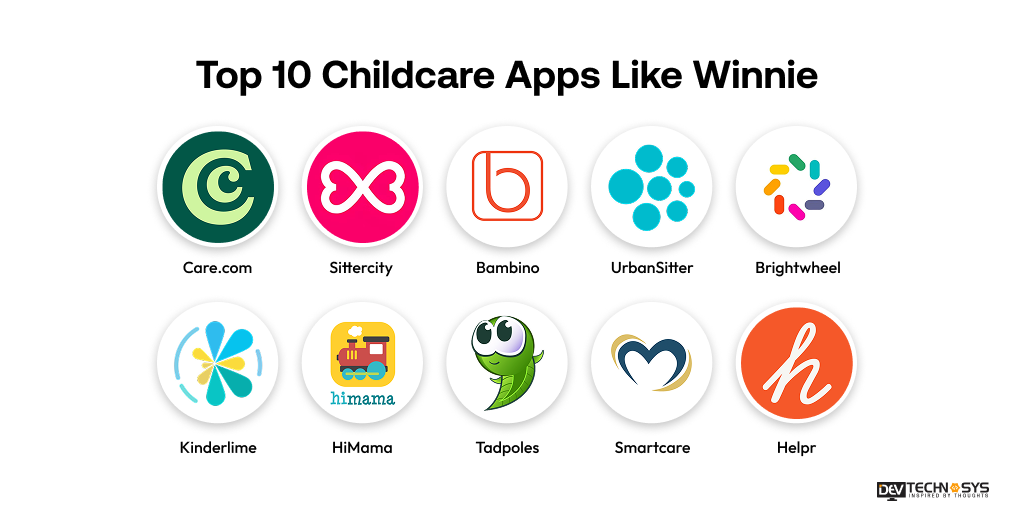
App Name |
Downloads |
Avg. Rating (out of 5) |
Launched Year |
Platform Availability |
| Care.com | 10M+ | 4.5 | 2006 | iOS, Android, Web |
| Sittercity | 5M+ | 4.4 | 2001 | iOS, Android, Web |
| Bambino | 500K+ | 4.6 | 2015 | iOS, Android |
| UrbanSitter | 1M+ | 4.3 | 2010 | iOS, Android, Web |
| Brightwheel | 3M+ | 4.8 | 2014 | iOS, Android, Web |
| Kinderlime | 2M+ | 4.5 | 2013 | iOS, Android, Web |
| HiMama | 2M+ | 4.7 | 2011 | iOS, Android, Web |
| Tadpoles | 1M+ | 4.6 | 2013 | iOS, Android, Web |
| Smartcare | 300K+ | 4.3 | 2015 | iOS, Android, Web |
| Helpr | 200K+ | 4.2 | 2016 | iOS, Android |
Why Entrepreneurs Want to Invest in Childcare App Development?
Childcare management app development offers entrepreneurs a compelling mix of market demand, monetization potential, scalability, and social impact, making it a highly attractive investment opportunity in today’s digital economy.
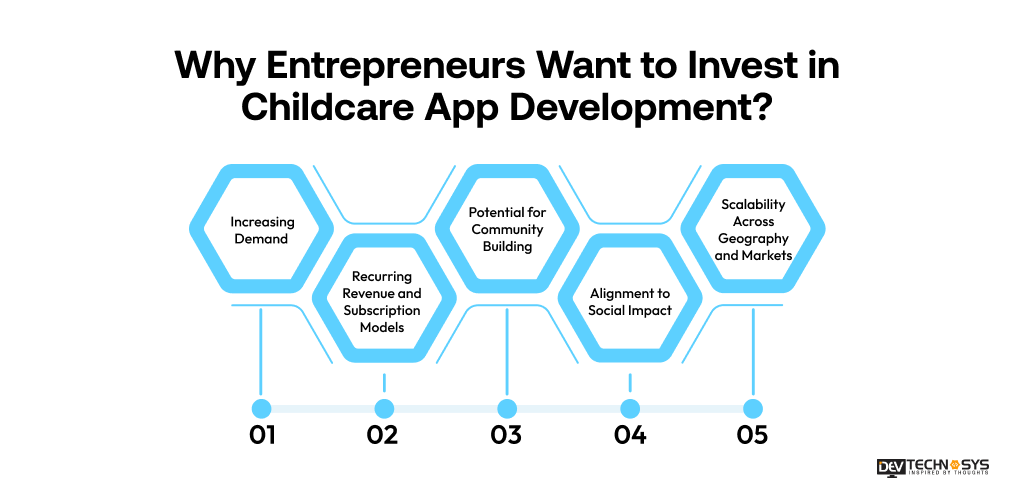
1. Increasing Demand
With a rising number of working parents and busy families, the need for simple digital platforms for finding, booking, and managing childcare is skyrocketing. Apps like Winnie serve a fundamental need by making it easier to find reputable daycare, babysitters, and preschools, resulting in a significant market potential.
2. Recurring Revenue and Subscription Models
Childcare management software development solutions sometimes use subscription-based or freemium models, which include premium services such as extensive reviews, background checks, and tailored suggestions. These monetization tactics provide consistent, recurring revenue, making the company model appealing to investors looking for long-term development.
3. Potential for Community Building
Successful childcare applications foster communities in which parents share their experiences, advice, and suggestions. This social feature promotes user retention and engagement, boosting loyalty and organic growth through word-of-mouth referrals, lowering customer acquisition expenses.
4. Alignment to Social Impact
Investing in childcare management app development services aligns with the broader social goal of promoting family and child development. Entrepreneurs realize the opportunity to make a difference by offering safer, more accessible childcare solutions, which improves brand reputation and attracts mission-oriented investors.
5. Scalability Across Geography and Markets
Winnie Connect childcare app requirements are universal, allowing applications to spread quickly across towns, states, and nations. By adding more childcare providers and improving features adapted to local legislation and cultures, these applications may reach large, underdeveloped regions, drawing a diverse user base.
What Benefits Can AI Offer Childcare Applications?
- AI personalizes activity recommendations based on a child’s developmental stage, enhancing learning and engagement effectively.
- AI-powered chatbots provide instant parent support and answer common childcare questions 24/7, improving user experience.
- Automated data analysis tracks children’s progress and alerts caregivers to developmental milestones or concerns early.
- AI streamlines provider matching by analyzing preferences, location, and availability, ensuring better childcare fit for families.
- Intelligent scheduling tools optimize booking and reminders, reducing no-shows and improving daycare management efficiency.
- AI enhances security through facial recognition and real-time monitoring, ensuring child safety in childcare centers.
7 Powerful Steps to Develop a Childcare App Like Winnie
From market research and feature planning to technology selection, development, rigorous testing, strategic launch, and continuous maintenance, follow these essential steps to build a successful, user-friendly childcare app that meets parents’ needs effectively. So, here we provide a robust childcare mobile application development process:
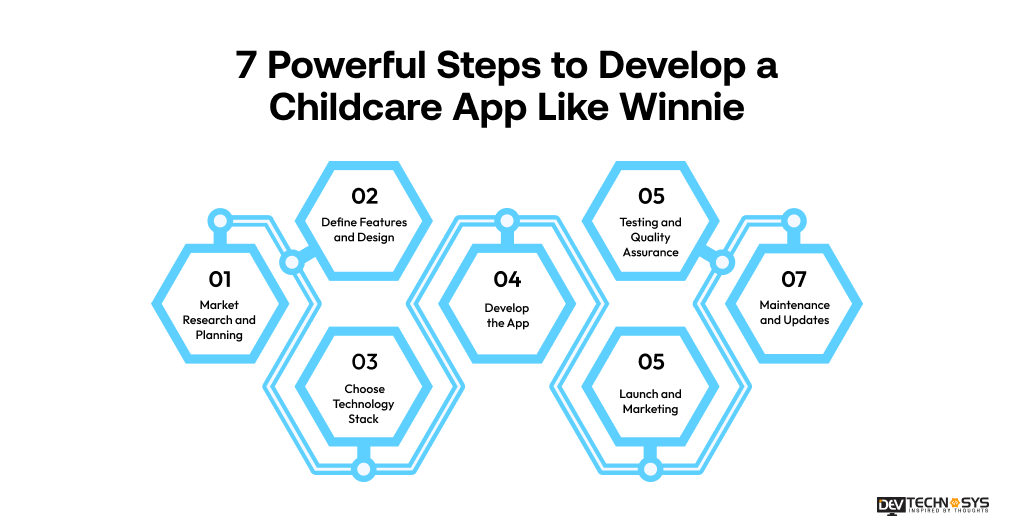
1. Market Research and Planning
Conduct thorough market research to understand parents’ needs, competitor apps, and industry trends. Define your app’s unique value proposition, target audience, core features, and monetization strategy. Hire dedicated developers to build a solution that effectively addresses user pain points and stands out in the competitive childcare app market.
2. Define Features and Design
Outline the app’s essential and advanced features, such as provider listings, reviews, booking, messaging, and activity tracking. Collaborate with UI/UX designers to create wireframes and prototypes focusing on simplicity and intuitive navigation, ensuring a user-friendly experience for both parents and childcare providers.
3. Choose Technology Stack
In the third stage to develop an app like Winnie, hire mobile app developers to select the appropriate technology stack based on your app’s requirements. Consider cross-platform frameworks like React Native or Flutter for mobile, scalable backend technologies like Node.js or Django, and databases such as PostgreSQL or Firebase.
A robust tech stack guarantees performance, scalability, and smooth app operation.
4. Develop the App
Start coding frontend and backend components simultaneously, integrating APIs, real-time features, and security protocols. Follow agile methodologies to allow iterative development, regular testing, and quick adjustments. Collaboration between developers, designers, and testers ensures high-quality app delivery.
5. Testing and Quality Assurance
Conduct comprehensive testing, including functional, usability, performance, and security tests. Hire professional coders from a baby tracking app development company to identify and fix bugs, optimize loading times, and verify seamless user interactions. Ensuring a bug-free and smooth experience is crucial for user retention and positive reviews.
6. Launch and Marketing
Deploy the app on relevant app stores with effective launch campaigns. Utilize social media, parenting forums, influencer partnerships, and local advertising to create buzz and attract initial users. Monitor user feedback and app analytics closely for continuous improvement.
7. Maintenance and Updates
Regularly update the app with new features, security patches, and performance enhancements based on user feedback and market trends. Ongoing mobile app maintenance service ensures the app remains competitive, reliable, and aligned with evolving user expectations and technology advancements.
Why do Customers or Parents Choose Winnie Over Various Childcare Apps?
Trusted for its verified listings, user-friendly design, real-time availability, supportive community, and valuable parenting resources, Winnie stands out as the go-to app for reliable, convenient childcare solutions. So, let’s figure out the following points:
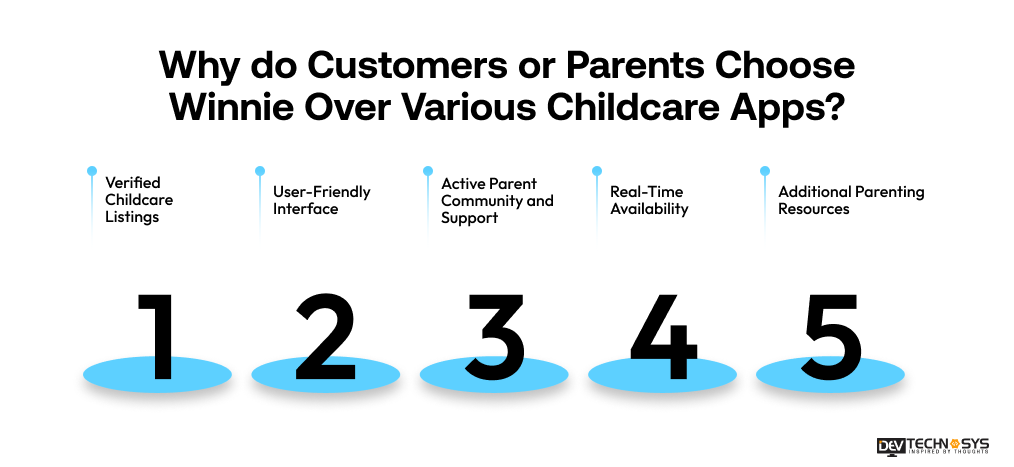
1. Verified Childcare Listings
Winnie clone apps provides a vast database of daycare facilities, preschools, and babysitters with verified profiles and full evaluations, providing parents confidence in selecting dependable and high-quality childcare alternatives that meet their specific needs.
2. User-Friendly Interface
If businesses develop a parental control app like Winnie, it will have a user-friendly interface that makes browsing and selecting childcare alternatives easier. Personalized suggestions based on geography, price, and kid age assist parents in rapidly identifying the best fits without overwhelming options.
3. Active Parent Community and Support
Winnie alternatives fosters a friendly environment where parents may share their personal experiences, guidance, and recommendations. This social component promotes participation and offers crucial firsthand information beyond standard daycare listings.
4. Real-Time Availability
Parents love the ease of monitoring provider availability in real time and booking directly through the app, which simplifies the daycare search process and saves time.
5. Additional Parenting Resources
Beyond daycare, Winnie provides parenting guidelines, developmental milestone trackers, and activity recommendations, making it a comprehensive platform that supports families throughout their parenting journey.
10 Must-Have Extraordinary Features of Childcare Apps Like Winnie
These features collectively create a trustworthy, convenient, and engaging platform that meets the diverse needs of modern parents searching for quality childcare.
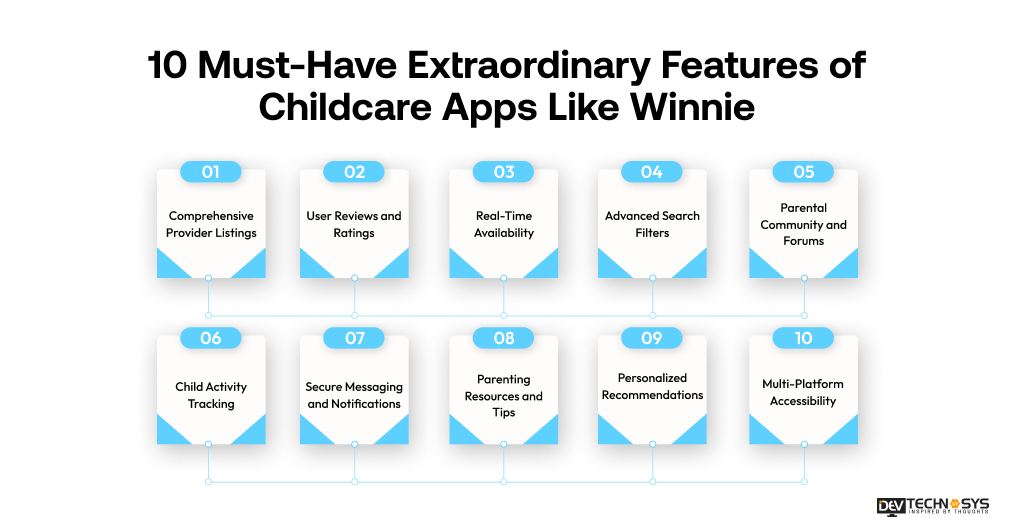
1. Comprehensive Provider Listings
Apps similar to Winnie offer a comprehensive directory of daycare facilities, babysitters, and preschools that includes verified profiles, images, and contact information.
2. User Reviews and Ratings
The best childcare app enables consumers to make educated decisions based on firsthand experience.
3. Real-Time Availability
An app like Procare, which allows parents to verify provider availability and book services directly from the app, speeds up the childcare search and scheduling process.
4. Advanced Search Filters
Apps similar to Winnie use filters for location, price, age group, services provided, and special needs assistance to help parents select the best option for their child’s needs.
5. Parental Community and Forums
The childcare app for parents allows them to exchange ideas, ask questions, and interact, boosts engagement, and offers additional support.
6. Child Activity Tracking
Winnie clone apps offer features that let caregivers log meals, naps, and activities, and keep parents informed about their child’s day-to-day routine.
7. Secure Messaging and Notifications
Safe, encrypted communication between parents and caregivers aids in care coordination, sharing updates, and ensuring prompt answers.
8. Parenting Resources and Tips
An app like FindMyKids, which provides articles, milestone checklists, and developmental activity suggestions, offers value and engages parents beyond daycare scheduling.
9. Personalized Recommendations
AI-powered recommendations based on user preferences and previous behavior enhance app usability and customer happiness.
10. Multi-Platform Accessibility
Winnie alternatives allow parents to access childcare services at any time and from any location, thanks to the availability on iOS, Android, and the web.
The Cost to Develop a Childcare App Like Winnie
The cost to build a childcare app like Winnie typically ranges from $8,000 to $25,000, depending on complexity, features, and platform choice (iOS, Android, or both). Basic apps with essential features like provider listings, reviews, and booking fall on the lower end.
But advanced functionalities, such as real-time availability, AI-driven recommendations, secure messaging, and community forums, increase development time and expenses.
Additional costs include UI/UX design, backend infrastructure, testing, and ongoing maintenance. Custom integrations and geographic expansion also affect the overall childcare management software development cost.
Feature/Service |
Estimated Cost Range (USD) |
| Core App Development (iOS & Android) | $10,000 – $20,000 |
| UI/UX Design | $5,000 – $8,000 |
| Backend Development & APIs | $7,000 – $12,000 |
| Real-Time Availability & Booking | $3,000 – $5,000 |
| AI-Powered Recommendations | $4,000 – $8,000 |
| Secure Messaging & Notifications | $2,000 – $4,000 |
| Testing & Quality Assurance | $3,000 – $5,000 |
| Maintenance & Updates (Annual) | $2,000 – $6,000 |
Estimated Development Cost: $8,000 to $25,000+
5 Major Factors That Affect the Childcare App Development Cost
Key cost drivers include app complexity and features, platform choice (iOS, Android, or both), the quality of UI/UX design, backend infrastructure and integrations, and the development team’s location and expertise, all of which influence the overall childcare app development cost.
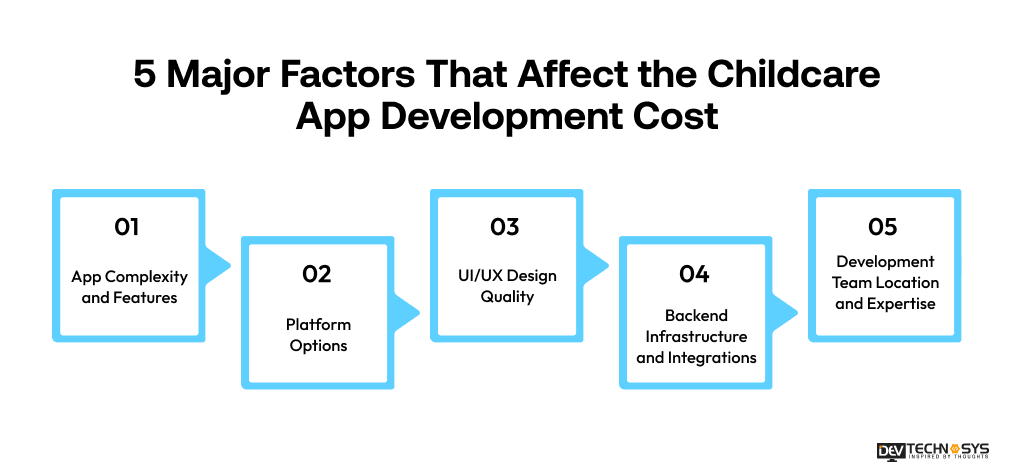
1. App Complexity and Features
The complexity and number of features heavily impact development costs. Basic applications that include important features such as provider listings and reviews are less expensive. However, adding complex features like real-time booking, AI-powered suggestions, encrypted messaging, and activity monitoring necessitates additional development time and resources, which raises the entire baby tracking app development cost.
Feature/Complexity Level |
Estimated Cost Range (USD) |
Description |
| Basic Features | $6,000 – $10,000 | Provider listings, reviews, basic search |
| Medium Complexity Features | $12,000 – $18,000 | Real-time booking, secure messaging, profiles |
| Advanced Features | $18,000 – $22,000+ | AI recommendations, activity tracking, video calls |
2. Platform Options
Choosing to design an app for a single platform, such as iOS or Android, saves startup expenses. However, supporting two platforms results in a larger user base but incurs more development costs. Cross-platform development can save money, but it may sacrifice performance and user experience, thus the decision affects Winnie app development cost.
Platform |
Estimated Cost Range (USD) |
Description |
| iOS Only | $15,000 – $20,000 | Development tailored for Apple devices |
| Android Only | $10,000 – $16,000 | Development for Android smartphones |
| Both iOS & Android (Native) | $16,000 – $22,000 | Separate native apps for each platform |
| Cross-Platform (React Native, Flutter) | $14,000 – $23,000 | Single codebase for both platforms, faster development |
3. UI/UX Design Quality
Investing in expert UI/UX design improves user experience and engagement while increasing mobile application development cost. Custom visuals, animations, and easy navigation need highly talented designers and lengthier production timelines. Although more expensive, high-quality design boosts user retention, making it a worthy investment in the app’s future success.
Design Aspect |
Estimated Cost Range (USD) |
Description |
| Basic UI Design | $3,000 – $7,000 | Simple layouts, standard components |
| Custom UI/UX Design | $7,000 – $15,000 | Custom graphics, animations, interactive flows |
| Branding & Visual Identity | $2,000 – $5,000 | Logo, color scheme, overall brand styling |
4. Backend Infrastructure and Integrations
A dependable backend is required to manage user data, real-time availability, reservations, and third-party interfaces such as payment gateways and mapping services. Scalable infrastructure demands more development time and resources, which raises the overall Winnie app development cost. Additionally, constant backend maintenance adds to long-term expenditures.
Backend Component |
Estimated Cost Range (USD) |
Description |
| Basic Backend Setup | $5,000 – $10,000 | User management, data storage |
| Real-Time Sync & APIs | $10,000 – $20,000 | Real-time availability, booking systems |
| Third-Party Integrations | $5,000 – $15,000 | Payment gateways, maps, notifications |
| Scalable Cloud Infrastructure | $10,000 – $21,000 | Supports growth, handles large user base |
5. Development Team Location and Expertise
The cost of kids learning app development varies depending on the team’s location and experience. Developers in North America and Europe often demand higher prices than those in Asia or Eastern Europe. While engaging skilled teams may be more expensive initially, their efficiency and quality decrease defects and maintenance expenses, resulting in superior long-term value.
Team Location |
Hourly Rate (USD) |
Typical Project Cost Range (USD) |
| North America | $50 – $70/hour | $28,000 – $50,000+ |
| Western Europe | $40 – $62/hour | $26,000 – $45,000 |
| Eastern Europe | $30 – $55/hour | $25,000 – $40,000 |
| Asia (India, SE Asia) | $15 – $25/hour | $8,000 – $25,000 |
Futuristic Tech Stacks to Develop a Childcare App Like Winnie
Technology Layer |
Recommended Tech Stack |
Description |
| Frontend (Mobile) | React Native, Flutter, Swift (iOS), Kotlin (Android) | Cross-platform frameworks for fast, smooth mobile apps |
| Backend | Node.js with Express, Django (Python), Ruby on Rails | Scalable, efficient server-side frameworks |
| Database | PostgreSQL, MongoDB, Firebase Realtime Database | Reliable storage with support for real-time updates |
| Cloud Hosting | AWS, Google Cloud Platform, Microsoft Azure | Scalable cloud infrastructure for storage and computing |
| AI & Machine Learning | TensorFlow, PyTorch, AWS SageMaker | For personalized recommendations and predictive analytics |
| Real-Time Communication | WebSocket, Firebase Cloud Messaging (FCM), Twilio | Enables instant messaging, notifications, and alerts |
| Payment Integration | Stripe, PayPal, Braintree | Secure and easy-to-integrate payment gateways |
| Security | OAuth 2.0, JWT (JSON Web Tokens), SSL/TLS | Secure authentication and data encryption |
| Analytics | Google Analytics, Mixpanel, Amplitude | User behavior tracking and app performance insights |
| DevOps & CI/CD | Docker, Kubernetes, Jenkins, GitHub Actions | Automated testing, deployment, and scalability |
5 Money-Generating Techniques of Childcare Apps Like Winnie
Childcare applications like Winnie may create long-term business models that benefit users and produce consistent profitability by integrating different income sources.
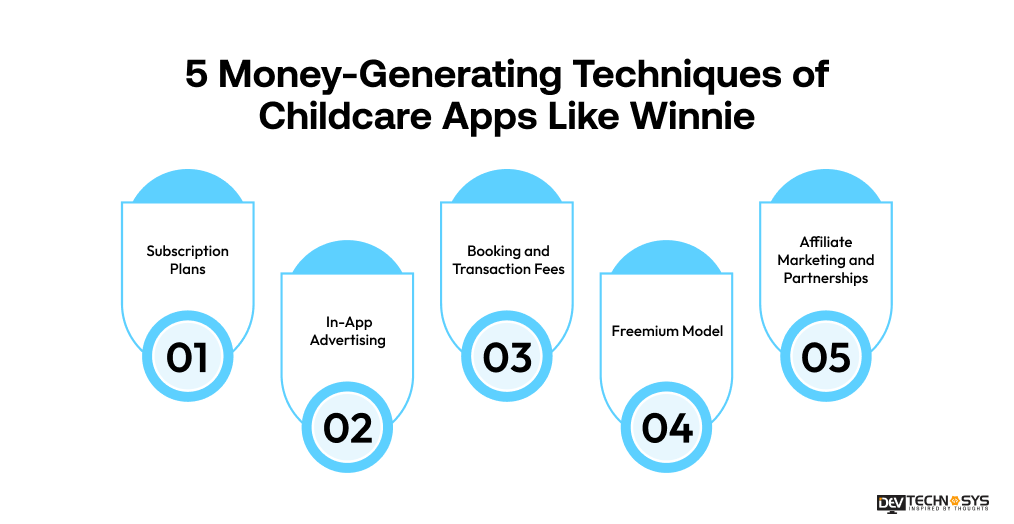
1. Subscription Plans
Winnie alternatives provide tiered subscription options for parents and daycare providers are the key income strategy. Parents get access to premium services, including extensive search filters, thorough provider profiles, background checks, and unlimited chatting. Providers can pay to increase their exposure, earn reservations directly, or have access to analytics tools, resulting in regular monthly or annual income.
2. In-App Advertising
If businesses develop an app like Brightwheel, it can display tailored advertisements in collaboration with family-focused corporations, educational materials, or local businesses. Carefully positioned adverts create cash without interfering with the customer experience. Native advertisements and sponsored listings may also be used, guaranteeing appropriate marketing for both advertisers and app users.
3. Booking and Transaction Fees
A tiny commission or service charge for reservations made through the app is a successful monetization strategy. When parents book babysitters or childcare places, the app takes a portion of the fee. This pay-per-use model links income with actual user interaction and service consumption, promoting ongoing platform activity.
4. Freemium Model
Winnie clone apps provide a free basic version of the program that draws a large user base, while premium upgrades unlock further functionality. These might offer priority customer service, thorough developmental tracking, or unique parenting materials. According to the mobile app development company, this concept strikes a balance between accessibility and potential for upselling.
5. Affiliate Marketing and Partnerships
Affiliate marketing allows childcare communication apps to create additional revenue by promoting appropriate products, services, or instructional content. Strategic relationships with toy makers, parenting courses, and childcare equipment suppliers enable applications to earn referral rewards, enhancing the user experience with useful information.
Conclusion
To develop a childcare app like Winnie, focus on user-friendly design, dependable provider listings, real-time booking, and secure communication. Integrate functionalities such as activity monitoring and tailored suggestions to augment parental involvement.
Collaborating with a proficient childcare management software development company guarantees seamless development, scalable infrastructure, and punctual delivery. Investing in appropriate technology and monetization tactics will provide a reliable, efficient platform that satisfies parental requirements and thrives in a competitive market.
Frequently Asked Questions
Q1. How Much Does It Cost To Develop a Childcare App Like Winnie?
The cost to build a childcare app like Winnie lies between $8,000 and $25,000, depending on features, platforms, design complexity, backend infrastructure, and the development team’s location and expertise.
Q2. How Long Does it Take to Create a Childcare App Like Winnie?
To create a childcare app like Winnie, it usually takes 3 to 6 months, depending on feature complexity, platform choice, design requirements, backend development, testing, and team size.
Q3. Which Technology Stack to Make a Childcare App Like Winnie?
Here are the key technology stacks to make a childcare app like Winnie:
- Frontend: React Native or Flutter for smooth cross-platform mobile apps
- Backend:js with Express or Django (Python) for scalable server-side logic
- Database: PostgreSQL or Firebase Realtime Database for reliable data storage
- Cloud Hosting: AWS or Google Cloud for secure, scalable infrastructure
Q4. Should I Allow Childcare Providers To Register Themselves?
Yes, allowing childcare providers to register themselves boosts platform content, scalability, and engagement. Ensure a robust verification process to maintain quality, trust, and safety for parents using the app.
Q5. Should I Include Messaging Between Parents And Providers?
Yes, including messaging enhances communication, builds trust, and simplifies coordination. Ensure it’s secure, user-friendly, and moderated to prevent misuse and maintain a safe environment for both parents and providers.
